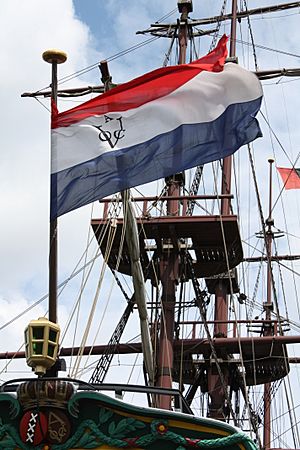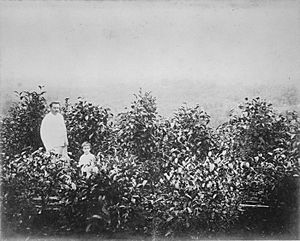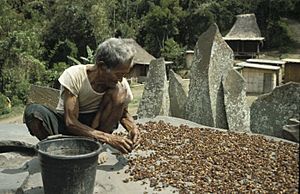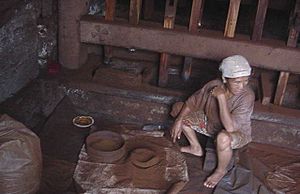Coffee production in Indonesia facts for kids
Indonesia is one of the world's biggest coffee producers. In 2014, it was the fourth-largest! Coffee growing started here in the late 1600s and early 1700s, during the time when the Dutch ruled the country. Coffee has played a big part in how Indonesia has grown.
Indonesia is a great place for coffee farms because it's near the equator. It also has many mountains on its main islands. These mountains create special weather conditions that are perfect for growing coffee.
In 2017, Indonesia produced about 660,000 tons of coffee. A lot of this coffee is used by people in Indonesia. The rest is sent to other countries. About 25% of the coffee sent out is Arabica beans. The rest is Robusta. Indonesian Arabica coffee usually has a mild taste and a strong body. This makes it great for mixing with coffees from Central America and East Africa, which often have a stronger, more acidic taste.
Contents
History of Coffee in Indonesia


The story of coffee in Indonesia began in 1696. The Dutch governor in India sent Arabica coffee seeds from Yemen to the Dutch governor in Batavia (which is now Jakarta). The first seeds didn't grow well because of floods. But a second shipment of seeds in 1699 was successful.
By 1711, the first coffee was sent from Java to Europe by the Dutch East India Company. By 1717, they had shipped 2,000 pounds! This coffee sold for very high prices in Amsterdam. Indonesia was the first place outside of Arabia and Ethiopia where coffee was grown widely.
The coffee was shipped from the port of Batavia. This port has been important since 397 AD. Today, in the Kota area of Jakarta, you can still see old ships loading goods. The Bahari museum, which used to be a warehouse for the Dutch East India Company, now stores spices and coffee.
In the 18th century, coffee from Batavia was very expensive in Amsterdam. But by the end of the 18th century, the price dropped. This meant more people could afford to drink coffee, not just the rich. During this time, Indonesia was the world's most important coffee supplier. It wasn't until the 1840s that Brazil started producing more coffee.
Growing coffee was very profitable for the Dutch rulers. However, it was tough for Indonesian farmers. From 1830 to about 1870, the colonial government forced farmers to grow coffee under a system called the Cultuurstelsel (Cultivation System). Instead of paying taxes, farmers had to give their crops, like coffee, sugar, and indigo, to government warehouses. This system took away time from growing rice, which caused hardship for farmers.
A famous book called Max Havelaar by Eduard Douwes Dekker (also known as Multatuli) was written in 1860. This book showed how unfair the "Cultivation System" was. It helped change how people in the Netherlands felt about their rule over Indonesia. Later, the name Max Havelaar was used by one of the first fair trade groups.
By the mid-1870s, the Dutch expanded Arabica coffee growing to other islands like Sumatra, Bali, Sulawesi, and Timor. In Sulawesi, coffee was likely planted around 1850. In North Sumatra, coffee was first grown near Lake Toba in 1888.
A big problem hit in 1876: a plant disease called coffee rust. It wiped out most of the Arabica coffee plants in Indonesia. To fix this, Robusta coffee was brought to East Java in 1900. Robusta is stronger against the rust disease, especially in lower areas. Robusta coffee quickly spread across southern Sumatra in the 1920s. Today, this area is still the biggest producer of coffee by volume.
After Indonesia became independent in the 1950s, the Dutch-owned coffee farms were taken over by the Indonesian government. New types of Arabica coffee were planted, and these were also shared with small farmers.
How Coffee is Grown
Today, most of Indonesia's coffee (over 90%) is grown by small farmers. Their farms are usually about one hectare (the size of two football fields). Some of these farms grow organic coffee, meaning they don't use man-made chemicals. Many farmer groups and sellers are certified to sell organic coffee.
There are more than 20 types of Arabica coffee grown in Indonesia. They fall into six main groups:
- Typica: This was the first type of coffee brought by the Dutch. Most of it was lost to coffee leaf rust in the 1880s. But you can still find some in Sumatra, especially in higher places.
- Hibrido de Timor (HDT): Also called "Tim Tim," this is a natural mix between Arabica and Robusta coffee. It was first planted in Aceh in 1979.
- Linie S: This group of coffees was first grown in India. Common types are S-288 and S-795, found in Lintong, Aceh, and Flores.
- Ethiopian lines: These include Rambung and Abyssinia, brought to Java in 1928. Another group, called "USDA," came to Indonesia in the 1950s.
- Caturra cultivars: Caturra is a changed version of Bourbon coffee, which started in Brazil.
- Catimor lines: This is another mix of Arabica and Robusta. Some types of Catimor found in Aceh have a great taste.
Coffee Regions in Indonesia
Sumatra (Mandheling, Lintong, and Gayo)
Coffee from Sumatra is very interesting and complex. This is because many small farmers grow it, and they use a special way of processing called "giling basah" (wet hulling). When the beans are green, they have a unique bluish color. This comes from the processing method and the soil.
Sumatran coffees are known for being smooth and sweet. They can have strong flavors like cocoa, tobacco, smoke, earth, and cedar wood. Sometimes, they can also have a fruity taste, like grapefruit or lime.
Mandheling is a trade name for Arabica coffee from northern Sumatra. It's named after the Mandailing people who grow coffee in the Tapanuli area.
Lintong
Lintong coffee grows in the Lintong Nihuta District, southwest of Lake Toba. This lake is one of the deepest in the world. The coffee farms are on a high plateau. This area produces a lot of Arabica coffee each year. A nearby area called Sidikalang also grows Arabica coffee.
Gayo
Gayo is a region in the hills around Takengon and Lake Laut Tawar, in northern Sumatra. The farms are high up, between 1,110 and 1,600 meters. Small farmers grow this coffee under shade trees. Gayo coffee is officially recognized as Kopi Arabika Gayo in Indonesia and Europe.
Farmers in this region usually process coffee using traditional wet methods. Because of the "giling basah" processing, Gayo Mountain coffee tastes lighter and less strong than Lintong and Mandheling coffees from other parts of Sumatra.
Sulawesi (Toraja, Kalosi, Mamasa, and Gowa)
The Indonesian island of Sulawesi is east of Borneo. The main area for high-altitude Arabica coffee is the Toraja highlands. Coffee is often traded through the town of Kalosi, which is a well-known name for special coffee. The regions of Mamasa and Gowa also grow Arabica.
Sulawesi coffees are clean and clear tasting. They often have nutty or warm spice flavors, like cinnamon or cardamom. Sometimes, you might taste a hint of black pepper. Their sweetness is linked to how full-bodied the coffee is. The taste stays on your tongue and is smooth.
Most of Sulawesi's coffee is grown by small farmers. The people of Tana Toraja have unique houses and old traditions. This respect for tradition also shows in how farmers process their coffee. Sulawesi farmers use the special "giling basah" (wet hulling) process.
Java
West Java was where the first coffee farms were set up by the Dutch East India Company. The Dutch started growing and selling coffee from Java in the 17th century.
In the late 1880s, a rust disease killed many coffee plants in Java. The Dutch then started growing Liberica and later Robusta coffee, which were more resistant to the disease.
Today, Java's Arabica coffee is mostly grown on the Ijen Plateau, in eastern Java, at over 1,400 meters high. This coffee is mainly grown on big farms built by the Dutch in the 18th century. The five largest farms are Blawan, Jampit, Pancoer, Kayumas, and Tugosari.
These farms quickly take ripe coffee cherries to their mills after picking. The fruit pulp is removed, and the beans are washed. This careful process makes coffee with a good, strong body and a sweet taste. They can sometimes have a unique, earthy flavor and a lasting finish.
This coffee is famous as part of the traditional "Mocha Java" blend, which mixes coffee from Yemen and Java. Some farms let their coffee beans age for up to five years. As they age, the beans turn light brown, and their flavor becomes stronger but less acidic. Aged coffees can taste like cedar or spices like cinnamon, and often become thick and syrupy. These are called Old Government, Old Brown, or Old Java.
The popular Java programming language was named after Java coffee!
Bali
The Kintamani region in Bali, between the Batukaru and Agung volcanoes, is the main coffee-growing area. Many coffee farmers in Bali are part of a traditional farming system called Subak Abian. This system is based on a Hindu idea called "Tri Hita Karana". It means that happiness comes from good relationships with God, other people, and nature. This idea encourages growing organic coffee and using natural fertilizers. The Subak Abian system is great for fair trade coffee because it helps organize small farmers.
In 2008, people in Bali created Indonesia's first Geographic Indication (G.I.) for coffee. This protects coffee grown in the Kintamani region under the name Kopi Arabica Kintamani Bali. It also helps market Kintamani coffee as special.
Balinese coffee is usually processed using the wet method. This makes a sweet, soft coffee with a good feel. It often has lemon and other citrus flavors.
Unlike other parts of Indonesia, Bali coffee has only one harvest season each year, usually from July to September. Most coffee in Bali is grown by small farmers.
Kopi tubruk is a traditional way to make coffee in Bali. It's made by putting finely ground coffee powder in hot water and letting it settle. You drink the coffee while trying to avoid the "mud" at the bottom of the glass.
Sumbawa
The western slopes of Mount Tambora in the Sanggar peninsula are the main coffee-growing area in Sumbawa island. Coffee has been grown here since at least the early 1800s, even before the huge eruption of Mount Tambora in 1815.
Flores
Flores Island is about 360 miles long and is located 200 miles east of Bali. Flores has many active and inactive volcanoes. The ash from these volcanoes makes the soil very fertile, which is great for growing organic coffee. Arabica coffee is grown high up on hillsides and plateaus. Most of it is grown under shade trees and processed by farmers using the wet method. Coffee from Flores is known for sweet chocolate, floral, and woody flavors.
Papua
The western half of New Guinea island is part of Indonesia and is called Papua.
There are two main coffee-growing areas in Papua. One is the Baliem Valley, around the town of Wamena. The other is the Kamu Valley, around the town of Moanemani. Both areas are high up, between 1,400 and 2,000 meters, which is perfect for Arabica coffee.
These areas produce about 230 tons of coffee each year. New companies are helping farmers get organic and fair trade certification, which will help them earn more money. These areas are very remote, and many coffee farms can only be reached by foot.
All coffee here is shade grown under trees like Calliandra, Erythrina, and Albizia. Farmers in Papua use a wet hulling process. They don't use chemical fertilizers or pesticides, which makes this coffee special and valuable.
Harvesting and Processing Coffee
All Arabica coffee in Indonesia is picked by hand. After picking, the coffee is processed in different ways. Each way adds its own flavors and smells to the final coffee.
A small number of Arabica farmers and most Robusta farmers use the oldest method: dry processing. The coffee cherries are dried in the sun, then the outer layers are removed when they are dry.
Most farmers in Sulawesi, Sumatra, Flores, and Papua use the "giling basah" (wet hulling) process. In this method, farmers remove the outer skin of the cherries using simple machines. The coffee beans, still covered in a sticky layer, are stored for about a day. Then, the sticky layer is washed off, and the coffee is partly dried before being sold.
Later, collectors and processors remove the rest of the outer layers when the coffee is still a bit wet. This gives the beans a unique bluish-green color. This process makes the coffee less acidic and gives it a stronger body, which is a classic Indonesian coffee taste.
Larger processing places and some farmer groups also produce "fully washed" coffee.
The most unusual way of processing coffee in Indonesia is for "kopi luwak". This coffee is processed by an animal called the Asian palm civet. These animals eat ripe coffee cherries. Their digestive system removes the outer parts of the fruit. The coffee beans that are left are then collected and washed. Experts believe that the special taste of kopi luwak comes from changes that happen during the civet's digestion. This makes a smooth, mild coffee with a sweet after-taste. Kopi luwak is very rare and can be very expensive.
Coffee Research and Groups
The Indonesian Coffee and Cocoa Research Institute (ICCRI) is in Jember, East Java. They do many things for coffee, like:
- Finding new areas to grow coffee.
- Studying coffee diseases and finding plants that can resist them.
- Teaching farmers better ways to grow and process coffee.
- Providing new and improved coffee plants.
- Supplying equipment for processing and testing coffee.
There are also groups that represent Indonesia's coffee industry. The Association of Indonesian Coffee Exporters (AICE) is for coffee sellers. The Specialty Coffee Association of Indonesia (SCAI) was formed in 2008. Its members focus only on growing, selling, and marketing Indonesia's Arabica coffees. This includes farmer groups, sellers, and coffee shops.
The Coffee Industry Today
Indonesia's coffee industry is very big and spread out. About 2 million small farmers grow coffee in many different villages across the islands. Each region has its own ways of growing, processing, and selling coffee. This makes it hard to move coffee around and to help farmers use new technologies. Many coffee farms have low yields, and farmers don't always have strong groups to help them.
Coffee is often grown near forests in Indonesia. In 2007, the World Wide Fund for Nature (WWF) reported that land was being cleared illegally for coffee farming in Bukit Barisan Selatan National Park in Sumatra. This park is home to endangered animals like tigers, elephants, and rhinos. WWF warned that these animals could disappear if the clearing continued.
Robusta Coffee
Growing areas Coffea robusta grows in lower areas than Coffea arabica. The island of Sumatra is the biggest producer. The provinces of Lampung, South Sumatra, and Bengkulu produce half of all the coffee in Indonesia, and up to 75% of all Robusta coffee. Smaller amounts are also grown in Kalimantan, Sulawesi, Bali, and Flores.
Production and processing Robusta is grown on small farms. Farmers harvest the coffee by stripping all the fruit from the branch, so there's a mix of ripe and green cherries. They dry the whole coffee cherries in the sun for up to three weeks. After drying, the dry cherries are hulled. Farmers sell the cherries to collectors, who then sell them to exporters or for use in Indonesia.
Markets Most of Indonesia's Robusta coffee is used to make instant coffee and other products. People in Indonesia use about 150,000 tons of Robusta each year. The main countries that buy Indonesian Robusta are the United States, Europe, and Japan. But demand is also growing from countries like Russia, China, and Malaysia.
Robusta is also an important part of traditional espresso blends. It adds special flavors and helps create the creamy foam, called crema, on top of the coffee.







